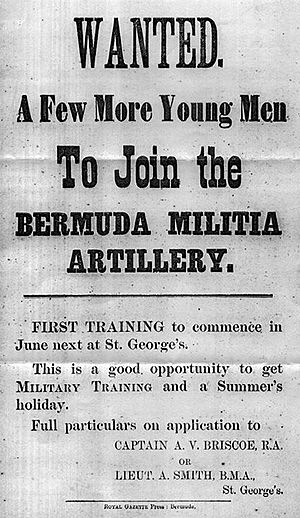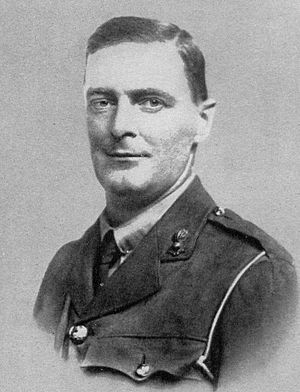Bermuda Militia Artillery facts for kids
Quick facts for kids The Bermuda Militia Artillery |
|
|---|---|

Cap Badge of the Royal Artillery
|
|
| Country | Bermuda (United Kingdom overseas territory) |
| Branch | |
| Type | Coastal artillery |
| Garrison/HQ | St. David's Battery |
| Anniversaries | 1 September 1965 (amalgamation into Bermuda Regiment) |
The Bermuda Militia Artillery (BMA) was a group of part-time soldiers in Bermuda. It was formed in 1895. Their main job was to help the British Army protect Bermuda's coast. They were like a backup team for the regular soldiers who guarded the big guns along the coast.
The BMA was called into full service during both World War I and World War II. They helped defend Bermuda. They also sent groups of soldiers to fight in other parts of the world.
Contents
History of Bermuda's Military Units
Bermuda has had its own local defence groups, called militias, since 1612. Back then, all healthy adult men had to serve. After the American War of Independence, the British built a big naval base in Bermuda. They also sent many regular British soldiers to protect it. Because of this, Bermuda's local government stopped paying for its own militia.
For about 80 years, British leaders asked Bermuda to create a new local defence force. But Bermuda's government was worried about the cost. They also worried about how to include or separate soldiers of different races.
In the 1830s, Governor William Reid tried to create a volunteer group. These soldiers were part-time. They joined the regular army and other military groups. There was no racial discrimination in who could join. But not many white Bermudians signed up. This early unit did not last long.
In the late 1800s, Britain wanted to move its regular soldiers from places like Bermuda. They wanted to use them for defence back home or send them to war zones. To do this, local forces needed to be created to take their place. But neither the British nor the Bermudian government wanted to pay for these new units.
Bermuda's new tourism industry helped solve this problem. The British government used its power to make Bermuda act. They would not approve new hotels or harbour improvements. They said Bermuda needed to help pay for its own defence first. So, Bermuda's government agreed to create new part-time military units.
Forming the Bermuda Militia Artillery
The Bermuda Militia Artillery (BMA) was officially formed in 1895. Even though it was called a "militia," it was actually a volunteer group. People chose to join it. Unlike some other volunteer groups, BMA members signed up for a set number of years.
Historically, artillery units were very important. They needed special training to operate the large coastal guns. By the mid-1800s, Bermuda had about 500 artillery guns. But there were not enough regular soldiers to operate them all. The BMA was created to help fill this gap.
The BMA was made up almost entirely of black soldiers. Their officers were white. Another volunteer unit formed at the same time, the Bermuda Volunteer Rifle Corps (BVRC), only recruited white soldiers. BMA recruits joined for six years. After basic training, they attended an annual camp. They wore the same uniform and cap badge as the Royal Artillery, a famous British army unit.
At first, soldiers joined voluntarily. But during World War II, and again in the 1950s, conscription was introduced. This meant people were required to join. Small groups of BMA soldiers went to England in 1897 and 1902 for special events. In 1896, the BMA started with just 10 men and three officers. It grew to over 200 men in ten years.
The First World War (1914-1918)
During World War I, two groups of BMA soldiers served in France. They were part of the Royal Garrison Artillery. The first group, with 201 officers and men, left Bermuda in May 1916. A second group joined them in France in May 1917.
These Bermudian soldiers mainly worked with ammunition. They moved supplies and delivered ammunition to the big guns on the battlefield. They served in important areas like the Battle of the Somme in 1916. They also helped the Canadian Corps during the Battle of Vimy Ridge in 1917. Later, they fought in the Battle of Passchendaele, where some men were killed or wounded. Two BMA soldiers received the Military Medal for their bravery.
When the war ended, the BMA in Bermuda was temporarily stopped. The soldiers who served overseas returned home in 1919. Field Marshal Sir Douglas Haig, a top British general, praised the Bermudian soldiers. He said they were "willing and efficient" and "conspicuous for their cheeriness under all conditions." He noted their excellent behaviour even when under enemy fire.
Between the World Wars


The BMA was restarted for its annual training camp in 1920. Many new recruits joined. In 1928, the regular British Army artillery units left Bermuda. The BMA took over full responsibility for operating the main coastal defence battery at St. David's Battery.
The BMA was also reorganized to be more like the Territorial Army in Britain. This meant soldiers had weekly training and a two-week annual camp. In 1931, a new unit, the Bermuda Volunteer Engineers (BVE), was formed. They helped operate searchlights at the battery.
In 1936, the BMA was involved in an unusual incident. They were firing a memorial salute for King George V. They were supposed to use blank rounds. But they ran out and had to use live ammunition for the rest of the salute. Luckily, the guns were aimed out to sea. A Colombian Navy ship happened to be in the area. The ship was not hit, but the crew was very surprised!
The Second World War (1939-1945)


When World War II began in 1939, Bermuda needed more soldiers. A new battery of guns was built at Warwick Camp. To get more soldiers, conscription was introduced. Black men were directed to join the BMA or a new unit called the Bermuda Militia Infantry (BMI). White men joined the BVRC. Soldiers served full-time during the war.
In 1940, a few BMA and BVE volunteers went to England. They joined regular British artillery or engineer units. One BMA officer, Lieutenant Patrick Lynn Purcell, served with coastal artillery in Sierra Leone. He later became a Major.
Some members of the Bermuda Militia also trained to become pilots. They joined the Royal Air Force or the Royal Canadian Air Force. One notable BMA officer, Second-Lieutenant Richard Masters Gorham, became a pilot. He served in North Africa and Italy. During the Battle of Monte Cassino, he bravely directed artillery fire from the air. He helped destroy a German division, which led to a major Allied breakthrough. For this, he received the Distinguished Flying Cross.
By 1943, American forces had arrived in Bermuda. This meant local Bermudian soldiers could be sent overseas. A group from the BMA and BMI went to North Carolina. There, they helped train a new unit called the Caribbean Regiment. This regiment later served in Italy as guards for prisoners of war.
After the war, the BMI and BVE were disbanded in 1946. The BMA and BVRC were kept, but with fewer members. Recruitment for both units started again in 1951.
After the War


The main reason for the military garrison in Bermuda was to protect the Royal Naval Dockyard, Bermuda. In 1950, it was announced that the dockyard would close. The regular British Army soldiers left Bermuda by 1957.
Even though their original role was gone, Bermuda's government decided to keep the BMA and BVRC. The last coastal artillery guns were removed in 1953. So, the BMA changed its role from artillery to infantry (foot soldiers). They still wore their Royal Artillery uniform and badge. The BMA moved to Warwick Camp, where the BVRC (now called the Bermuda Rifles) was also based. Conscription was brought back for both units.
In 1965, to end racial segregation and combine efforts, the BMA and the Bermuda Rifles joined together. They formed a new unit called the Bermuda Regiment. Since 2015, it has been known as the Royal Bermuda Regiment.
The BMA and BVRC were important parts of Bermuda's history. They helped protect the island and sent soldiers to fight in major wars. Today, the Royal Bermuda Regiment carries on their legacy.
See also
- Militia Artillery units of the United Kingdom and Colonies
- Bermuda Garrison
- Royal Bermuda Regiment
- Royal Artillery
- British Army
- Territorial Army (United Kingdom)
Part of









